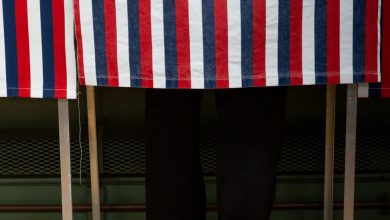You Know the Saying: You Are the Product

When is free not free?
I’ve been thinking a lot about that, as Twitter this week finally offered its “Blue” subscription to customers in the United States and New Zealand, after testing it in Canada and Australia. Twitter put some real effort into providing news-loving users like me a reason to fork over $3 a month for a service that’s otherwise, well, free (sort of). That includes ad-free articles from media outlets like The Washington Post, BuzzFeed and Rolling Stone, and a feed of the most popular news items in your network over the past day — ensuring you won’t look clueless at tonight’s cocktail party.
There’s also an “undo” feature for preventing oopsie moments by allowing a tweet to be recalled within 30 seconds of sending it. And, I assume, more to come (including inevitable price hikes). Amazon Prime was pretty bare-bones when it debuted for $79 a year in 2005, but it now has some 200 million subscribers worldwide getting speedy shipping, streaming video and other goodies. YouTube’s seven-year-old Premium service, which cuts out ads, has tens of millions of users. Twitter is late to the party, but I am glad to see it getting serious about providing services its most dedicated users might want so much that they’ll pay for them.
With Twitter dipping its toes into paid subscriptions, it’s a good time to think more broadly about tech’s business models, which offer free services by shoveling gobs of data in the direction of marketers to underwrite them. It’s also a good time to think over how to responsibly regulate these mega-corporations.
In recent interviews I’ve had with a diverse set of thinkers such as Aswath Damodaran, professor of finance at New York University; the futurist and computer scientist Jaron Lanier; lawmakers like Senator Amy Klobuchar; and others who know a thing or two about the digital sector, every single one zeroed in on what they said is the main problem with Big Tech: business models that hoover up personal data.
Of course, this is nothing new. Privacy concerns are why lawmakers around the world have in recent years been pushing back against the Googles and Facebooks that are incentivized to collect as much rich digital information as possible from their users. With the explosive growth of online advertising, we’ve been sliced and diced and labeled to help ensure we see only ads and content that we are sure to find “relevant.”
This has left companies like Facebook, er, Meta (ugh, I told you this was going to be hard) with what Damodaran correctly calls an “odious” reputation, because their sales growth ranks higher than any focus on consumer — and societal — protections. Lanier, for his part, calls it a “manipulative business model,” and Klobuchar has noted that we end up paying for anything free somewhere along the line. I applaud the shift in focus on how to build a business model and an economy that encourage better outcomes.
Still, the common excuse from tech leaders — particularly at Google and Meta — is that the “free” internet requires them to sponge up as much about us as possible. But I have long held that it only makes all of us cheap dates to these companies. Sure, we get digital maps or email, but like a craps table in Las Vegas, the house inevitably wins.
I have to hope Twitter’s Blue is a step toward a model that is less reliant on surveilling users. Aligning customer and business incentives ought to be viewed as a good thing, even if so much of the internet has grown up gobbling up data. Of course we have to be careful not to build premium services on the backs of customers who cannot really afford to pay for digital services — any paywall is, well, a wall.
They say there is no such thing as a free lunch; well, that’s never been more true than on today’s internet. But without any real regulatory oversight, why wouldn’t these fabulously profitable companies keep doing what they’re doing?
And while we’re dreaming of a better way … Jack Dorsey: For the love of late-night Twitter indiscretions, I will pay anything for editable tweets.
5 Questions
This week I connected with my colleague Farah Stockman, a member of the Times editorial board, to talk about labor and her recently published book, “American Made: What Happens to People When Work Disappears.” We’ve edited her answers.
In “American Made” you trace the stories of three workers at a bearing factory in Indiana and how they coped with their jobs moving to Mexico. Why pick this example of the changing work force, and what does it represent?
I picked that factory because it felt like a microcosm of American politics at the time. The factory announced that it was moving to Monterrey, Mexico, in the fall of 2016, just before Donald Trump’s election. A few weeks later, Mexican workers were brought to the Indianapolis plant for training, stoking a wide range of reactions: anger, despair and hope for Trump to swoop in and save the factory. The story of Rexnord, a bearing company, opened my eyes to the role that globalization has played in sowing working-class distrust of the elite. Blue-collar Americans — once a pillar of the Democratic Party — flocked to cast ballots for a Republican who had promised at rally after rally that he’d save their jobs. It’s not enough to recognize that the work force is changing. We have to recognize who benefits from those changes and who loses out. We have to understand who is being blamed. It’s one thing to lose your job to technological advances — people can understand that. Losing your job because of a free-trade agreement with a low-wage country that was crafted by elected officials in Washington who are supposed to look after your interests is another thing entirely.
Gig workers are another group whose numbers have swelled in recent years with the advancement of the digital economy imposed on the physical one. Can you compare and contrast those changing work forces?
Look up “gig worker” in the dictionary and it is pretty much the polar opposite of everything that unions fought for in the golden age of American manufacturing.
I’m reminded of a story of what it was like to be a steelworker before unions. You had to hang out outside the factory walls, begging the foreman for a chance to work that day. If the foreman didn’t like the looks of you, or bore some other grudge, you didn’t get to work that day, and your children starved. It is because of the labor movement that jobs became predictable in terms of pay and hours. Paid time off, profit-sharing, pensions and health insurance — once luxuries that were only given to management — filtered down to blue-collar factory workers because of strikes.
Today, gig workers seem a little bit like the steelworkers in the old days, looking for a job for the day. They have freedom, but not the predictability and protection that comes from being employed. Rexnord was a place that helped its workers access treatment for alcoholism and drug addiction. It paid for you to go back to school if you wanted a degree. If you got into an accident or had a kid in the hospital, co-workers would pass a hat and collect money for you. For Shannon, a female steelworker I followed for the book, the factory was an anchor in an otherwise chaotic life. She knew exactly what time she had to be at work each day and exactly what to do once she got there. After the factory closed, she had a hard time figuring out what to do with her time. She called up an old mentor from the plant and asked him, “Will you be my boss?” Some people are just not cut out for “gig” work, which strikes me as much more solitary and devoid of the structure, guidance, training and long-term commitments that many people need to thrive.
Due to the pandemic, the work force has changed dramatically again with labor in the leverage seat and companies struggling to staff up. Some people call it the Great Resignation and others the Great Reassessment. How do you see it?
I think there are several things going on all at once. Some people worked harder than ever during Covid, at great personal risk. Nurses, cashiers, bus drivers, care givers for the elderly. I expect those people are burned out and ready to quit just so they can have a rest. Other people in the “knowledge economy” continued their jobs from home. Many of them kept getting their paychecks but reduced their expenses to such an extent that they have money in the bank and time to think about what it is they really want to do with their life and whether they really wanted to spend two hours a day going to and from work.
The habit of going to work has been broken. A lot of blue-collar Americans, like Shannon, worked jobs that couldn’t be done from home. Many got laid off when the economy slowed down. Shannon made more money from unemployment checks during Covid than she had earned working. Many people who had been living hand-to-mouth now have money in the bank that they didn’t have before. According to JPMorgan Chase Institute, the median household’s checking account balance was 50 percent higher in July of 2021 than in 2019. That means that people actually didn’t have too much financial pressure on them to return to work, even in states that cut off the Covid support. I expect that those people will spend down their savings and eventually return to work.
What are some key trends going on in the workplace that we need to pay attention to that may impact the future work force?
We are entering an era of continuous learning. It’s not enough to have a college degree from a decade ago. People are going to have to continuously master new skills to remain viable in the workplace. I expect to see more people rely on short technical certification classes than on formal college degrees. A younger friend who grew up in public housing chose to focus on obtaining Microsoft certifications rather than attending college, and she’s done well for herself as an office manager and now an entrepreneur. And she has zero regrets about not having a four-year degree. Elite colleges are still going to be a thing, since they are a built-in social network. But many workers and companies are going to continue to find alternatives to traditional college.
What will recent infrastructure commitments and other regulations do to the work economy?
I expect the infrastructure bill recently passed by Congress to produce a lot of good-paying blue-collar jobs, not just in the construction of roads and bridges but also in laying broadband. Bringing broadband to certain parts of the country could be as big a deal as when the New Deal brought electricity to rural America in the 1930s. If people in the “knowledge economy” can do their jobs from places like Morgantown, W.Va.— which is full of mountain-biking trails and beautiful rivers — they might move there instead of paying a gazillion dollars for a house in Oakland, Calif., with no backyard. If well-off employees in the digital economy spread more evenly across the country, then the benefits of that part of the economy could be reaped by blue-collar workers — construction crews, restaurant staff, auto mechanics, maids and babysitters — in the Rust Belt and beyond. That could help cure our political polarization, with is tied to our economic and geographic separation.
Tim Cook takes a bite at the crypto Apple
Apple’s chief executive, Tim Cook, outed himself as a crypto dude in an interview with The Times’s Andrew Ross Sorkin at the DealBook Online Summit this week.
“I think it’s reasonable to own it as part of a diversified portfolio,” he said, quickly clarifying that it’s his own money and that Apple would not be delving into the Bitcoin anytime soon — even though that cryptocurrency hit all-time highs this week. “I don’t think people buy Apple stock to get exposure to crypto.”
Indeed not, but Apple will have to lean into other payment systems. Federal Judge Yvonne Gonzalez Rogers ruled against Apple in its motion for a stay in the continuing case pitting the company against Fortnite-maker Epic Games over Apple’s prohibitions on alternative payment options in the App Store. Apple has argued that external payment links could lead to scams and compromise safety for App Store users. But Rogers wasn’t having any of that. “Apple’s motion is based on a selective reading of this court’s findings and ignores all of the findings which supported the injunction,” she wrote. “Apple has provided no credible reason for the court to believe that the injunction would cause the professed devastation.”
In other words, time to payment up, Apple.
There’s over the top and then there’s this …
Old-money San Francisco finally outdid the newbies of tech with a wedding so over the top that it practically begged to become satire. The luxurious three-day nuptials of Ivy Getty, as in oil money Getty, featured a mod dance party at the Palace of Fine Arts and wrapped up at City Hall, tricked out in wall-to-wall carpeting, with Nancy Pelosi as officiant. Also on the guest list: Gov. Gavin Newsom of California, Mayor London Breed of San Francisco, “Queen’s Gambit” star Anya Taylor-Joy and Olivia Rodrigo, with Earth, Wind & Fire performing.
The event was chronicled by Vogue with exquisite photos and so, so many epic lines.
Like: “The wedding day started with a pajama party. ‘We have the whole mezzanine level,’ Getty explains. ‘There’s a styling room with all of the extra clothes, and there’s two hotel rooms that they removed all of the hotel furniture from and then there are these individual Margiela boxes with all of the bridesmaids’ names engraved on them.’’’
And from the designer John Galliano: “You can’t imagine getting these girls all together at Claridge’s at 4 a.m. in the morning, walking around in peignoirs for 48 hours to do their fittings. They were so lovely and such fun. Some of the dresses have taken on a more bias-cut influence, and some have taken on a double-layering technique played out in pale, thunderous grays and lilacs, with lamés woven to echo those colors.”
I can imagine, John.
To be clear, I am not trying to shame the rich here — though many on Twitter have with great enthusiasm this week (my fave: “Yo Ivy: Read the room”) — especially since the richer tech folks have had just as many insane parties that have not been covered. I only encourage you to read the piece because, well, just because.
Have feedback? Send a note to [email protected].





